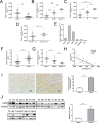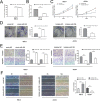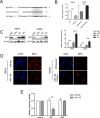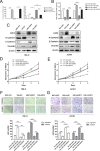miR-155 regulates the proliferation and invasion of clear cell renal cell carcinoma cells by targeting E2F2
- PMID: 26967247
- PMCID: PMC4991458
- DOI: 10.18632/oncotarget.7951
miR-155 regulates the proliferation and invasion of clear cell renal cell carcinoma cells by targeting E2F2
Abstract
MicroRNAs (miRNAs) have emerged as critical modulators of carcinogenesis and tumor progression. In the present work, we sought to identify the biological function of miR-155 as well as its underlying mechanism in clear cell renal cell carcinoma (ccRCC). We examined the expression of miR-155 in clear cell RCC (ccRCC) and adjacent normal tissues and then explored the roles of miR-155 both in vitro and in vivo. The results of this analysis indicated that miR-155 activity was significantly upregulated in ccRCC tissues compared with the corresponding normal tissues. miR-155 was associated with ccRCC aggressiveness in both cell lines and clinical specimens, and a specific and inverse correlation between miR-155 and E2F2 expression was found in human ccRCC samples. Overexpression of miR-155 in 786-O cells decreased E2F2 expression while reduction of miR-155 by anti-miR-155 in ACHN cells elevated E2F2 expression. Re-expression of E2F2 in 786-O cells repressed the cell migration/invasion abilities elevated by miR-155, whereas knockdown of E2F2 in ACHN cells restored these cellular functions hampered by the miR-155 inhibitor. Using Western blot and luciferase reporter assays, we determined that E2F2 was a direct target of miR-155. Taken together, the in vitro and in vivo results demonstrate that miR-155 functions as a tumor-promoting miRNA by targeting E2F2 in ccRCC.
Keywords: E2F2; clear cell renal cell carcinoma; miR-155; proliferation and invasion.
Conflict of interest statement
The authors declare no conflicts of interest.
Figures






Similar articles
-
LncRNA RCAT1 promotes tumor progression and metastasis via miR-214-5p/E2F2 axis in renal cell carcinoma.Cell Death Dis. 2021 Jul 9;12(7):689. doi: 10.1038/s41419-021-03955-7. Cell Death Dis. 2021. PMID: 34244473 Free PMC article.
-
The lncRNA SNHG5-mediated miR-205-5p downregulation contributes to the progression of clear cell renal cell carcinoma by targeting ZEB1.Cancer Med. 2020 Jun;9(12):4251-4264. doi: 10.1002/cam4.3052. Epub 2020 Apr 12. Cancer Med. 2020. Retraction in: Cancer Med. 2023 Feb;12(4):5172. doi: 10.1002/cam4.5090. PMID: 32281285 Free PMC article. Retracted.
-
MATN1-AS1 Promotes Tumour Metastasis and Sunitinib Resistance via E2F2 in Clear Cell Renal Cell Carcinoma.J Cell Mol Med. 2025 Feb;29(4):e70428. doi: 10.1111/jcmm.70428. J Cell Mol Med. 2025. PMID: 39999286 Free PMC article.
-
The role of natural products versus miRNA in renal cell carcinoma: implications for disease mechanisms and diagnostic markers.Naunyn Schmiedebergs Arch Pharmacol. 2024 Sep;397(9):6417-6437. doi: 10.1007/s00210-024-03121-8. Epub 2024 May 1. Naunyn Schmiedebergs Arch Pharmacol. 2024. PMID: 38691151 Review.
-
The role of E2F2 in cancer progression and its value as a therapeutic target.Front Immunol. 2024 May 14;15:1397303. doi: 10.3389/fimmu.2024.1397303. eCollection 2024. Front Immunol. 2024. PMID: 38807594 Free PMC article. Review.
Cited by
-
Decreased E2F2 Expression Correlates with Poor Prognosis and Immune Infiltrates in Patients with Colorectal Cancer.J Cancer. 2022 Jan 1;13(2):653-668. doi: 10.7150/jca.61415. eCollection 2022. J Cancer. 2022. PMID: 35069909 Free PMC article.
-
Non-Coding Micro RNAs and Hypoxia-Inducible Factors Are Selenium Targets for Development of a Mechanism-Based Combination Strategy in Clear-Cell Renal Cell Carcinoma-Bench-to-Bedside Therapy.Int J Mol Sci. 2018 Oct 29;19(11):3378. doi: 10.3390/ijms19113378. Int J Mol Sci. 2018. PMID: 30380599 Free PMC article.
-
Inhibition of MicroRNA-149-5p Induces Apoptosis of Acute Myeloid Leukemia Cell Line THP-1 by Targeting Fas Ligand (FASLG).Med Sci Monit. 2016 Dec 25;22:5116-5123. doi: 10.12659/msm.899114. Med Sci Monit. 2016. PMID: 28013316 Free PMC article.
-
Identification of miRNAs and Their Target Genes Associated with Sunitinib Resistance in Clear Cell Renal Cell Carcinoma Patients.Int J Mol Sci. 2024 Jun 22;25(13):6881. doi: 10.3390/ijms25136881. Int J Mol Sci. 2024. PMID: 38999991 Free PMC article.
-
Aberrantly expressed microRNAs in bladder cancer and renal cell carcinoma.J Hum Genet. 2017 Jan;62(1):49-56. doi: 10.1038/jhg.2016.84. Epub 2016 Jun 30. J Hum Genet. 2017. PMID: 27357429 Review.
References
-
- Siegel R, Naishadham D, Jemal A. Cancer statistics, 2013. CA Cancer J Clin. 2013;63:11–30. - PubMed
-
- Ljungberg B, Cowan NC, Hanbury DC, Hora M, Kuczyk MA, Merseburger AS, Patard JJ, Mulders PF, Sinescu IC, European Association of Urology Guideline G EAU guidelines on renal cell carcinoma: the 2010 update. European urology. 2010;58:398–406. - PubMed
-
- De Meerleer G, Khoo V, Escudier B, Joniau S, Bossi A, Ost P, Briganti A, Fonteyne V, Van Vulpen M, Lumen N, Spahn M, Mareel M. Radiotherapy for renal-cell carcinoma. The Lancet Oncology. 2014;15:e170–177. - PubMed
-
- Albiges L, Fay AP, Xie W, Krajewski K, McDermott DF, Heng DY, Dariane C, DeVelasco G, Lester R, Escudier B, Choueiri TK. Efficacy of targeted therapies after PD-1/PD-L1 blockade in metastatic renal cell carcinoma. Eur J Cancer. 2015;51:2580–6. - PubMed
MeSH terms
Substances
Supplementary concepts
LinkOut - more resources
Full Text Sources
Other Literature Sources
Medical

